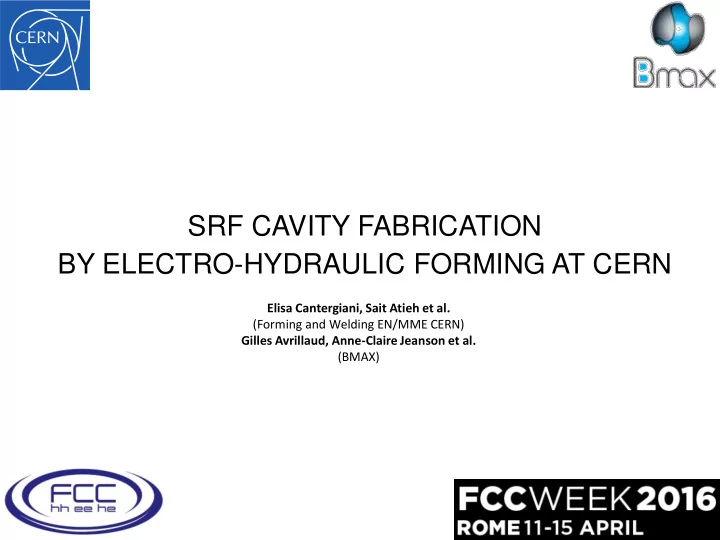

SRF CAVITY FABRICATION BY ELECTRO-HYDRAULIC FORMING AT CERN Elisa Cantergiani, Sait Atieh et al. (Forming and Welding EN/MME CERN) Gilles Avrillaud, Anne-Claire Jeanson et al. (BMAX)
STATE OF ART FORMING OF SRF CAVITIES Deep-drawing of half-cells Spinning of copper half-cells • • Multiple steps required to shape blank Requires high tonnage hydraulic press for large into final profile without defects; cavities; • • Many parameters to be adjusted: Feed A coining step is necessary to obtain the curvature ratio, Roller path, Roller design, at the iris; Spinning ratio; • Spring-back of niobium is an issue; • Intermediate annealing steps (ok for • copper, very difficult for Nb); Damaged layer left on the surfaces (100-200 µm) Elisa Cantergiani 2
MOTIVATION Investigate new forming processes which simplify the forming of symmetric and asymmetric SRF cavities (i.e. CRAB); High Shape Accuracy; Reduce post-processing cost and time; Reduce cost and time of forming High strain-rate forming processes can help in satisfying the above requirements: Increase in metal formability; Reduced springback; High reproducibility; Reduced manufacturing cost; Collaboration CERN/BMAX to produce symmetric SRF cavities by using electro-hydraulic forming Elisa Cantergiani 3
ELECTRO-HYDRAULIC FORMING 4
ELECTRO-HYDRAULIC FORMING Parameters to be considered during EHF: • Position of electrodes; • Input energy magnitude; E=1/2(CV 2 ) • Number and duration of pulses; • Chamber geometry; • Type of material to be formed (thickness); Elisa Cantergiani 5
ELECTRO-HYDRAULIC FORMING 3 half-cells from 3 mm OFE-Cu sheets; 3 half-cells from 3.6 mm Nb sheets; 6
CHARACTERIZATION OF THE STARTING NIOBIUM SHEET RRR measurements: • 5 specimens cut in longitudinal direction of the Nb sheet; Raw Dimensions: • 2mm x 2mm x 100mm 5 specimens cut in transversal direction of the Nb sheet; • Specimens were degreased and chemically attacked to remove 300 µm; Temperature measurements Resistivity versus temperature curves 3 specimens on the front and 3 on the back - Applied current 5 A; - Warm-up and cool-down procedure performed by using liquid He; 7
CHARACTERIZATION OF THE STARTING NIOBIUM SHEET RRR Measurements: • Results obtained by regression of the resistivity vs temperature curves in the range 9.3K up to 17-20K; Longitudinal Transversal R ( 295 K ) RRR Specimen RRR Specimen RRR R ( 4 . 2 K ) L1 401 T1 375 L2 412 T2 358 L3 399 T3 373 L4 556 (*) T4 351 L5 390 T5 318 (*) Average 401 Average 364 Removing (*) Removing (*) STD 9 STD 12 Values of RRR are > 300 along both directions (according to SRF cavities requirements); 8
CHARACTERIZATION OF THE STARTING NIOBIUM SHEET • Vickers Hardness HV10 should be max. 60 according to SRF requirements; (average values declared by supplier: 47-52); Average HV 10 STD 51 3 • Vickers Hardness HV0.2 through thickness: average value 57 and STD ± 4; Microstructure on surface Microstructure through thickness TD TD RD RD Average grain size number: 5.5 (Ø of grains 53 µm) (ASTM E112-96(2004)). 9
COMPARISON BETWEEN EHF AND SPINNING After forming of the metal, the dislocation density is increased Dislocation density is related to hardness; Specimens were cut along the profile of the two formed cavities and a number was assigned to them based on their position; Specimen 5 – (close to the equator) Specimen 9 – Specimen 15 – (middle of the cavity profile) (close to iris of the cavity profile) Surface Vickers Hardness (HV 10) and Vickers Microhardness (HV 0.2) were compared for both forming techniques; 10
COMPARISON BETWEEN EHF AND SPINNING Equator Equator Iris Iris 11
RRR OF ELECTRO-HYDRAULIC FORMED HALF CELLS RRR value is related to the density of dislocations RRR specimens extracted in circumferential direction close to the iris; RRR specimens annealed at 600 °C/700 °C and 800 °C for 5h in vacuum (10 -6 mbar); Annealing Average RRR 600 °C – 5h 395 Recovery of RRR values and recovery 700 °C – 5h 393 of dislocations; 800 °C – 5h 384 12
SURFACE FINISH OF ELECTRO-HYDRAULIC FORMED CAVITY R a arithmetic average of roughness absolute values; R t distance from the highest peak to the deepest valley; Nb RF surface OFE Cu RF surface OFE Cu outer surface Id Ra sheet (µm) Rt sheet (µm) Ra EHF (µm) Rt EHF (µm) OFE 0.2 3.5-5.8 0.2 2-12 Nb 0.8-0.9 7-11 0.9-1 8-11 Conservation of surface roughness; Shape Accuracy: ± 200 μ m for Nb, ± 150 μ m for Copper against ± 600 – 800 μ m for deep- drawing and spinning; 13
EBSD OF ELECTRO-HYDRAULIC FORMED CAVITY Not Deformed =1000 µm; IPF-Z1+GB; Step=5 µm; Grid708x65 No plastic strain present through thickness; =1000 µm; KAM 3x3; Step=5 µm; Grid708x65 Deformed close to iris =1000 µm; IPF-Z1+GB; Step=5 µm; Grid535x82 Uniform distribution of plastic strain through thickness; =1000 µm; KAM 3x3; Step=5 µm; Grid535x82 14
TEM OF ELECTRO-HYDRAULIC FORMED CAVITY External surface External surface External Surface: Twins present in whole grains; Internal Surface: NO twins but presence of bundles of dislocations; Internal surface Internal surface (Results obtained in collaboration with ETH Zürich) 15
BMAX NIOBIUM CHARACTERIZATION FEM modelling of EHF: isotropic yield function + Johnson-Cook rate dependent model; Temperature Uniform strain- Strain-rate sensitivity hardening sensitivity High speed testing in industrial manufacturing conditions: Testing by magnetic pulse forming (tube expansion test); o Rogowski coil (measurement of pulse electrical current); o Photonic doppler velocimetry (PDV); o 16
Conclusions and Future Work Electro-hydraulic forming is a promising technique to form axial symmetric SRF cavities; The damage caused inside the material (density of dislocations) is lower compared to spinning processes; The conservation of surface roughness, low wall thickness variation and lower damage compared to spinning, could lead to an important reduction of post forming related surface treatment, as buffered chemical polishing (BCP) and electropolishing (EP). 17
THANK YOU FOR YOUR ATTENTION 18
DISTRIBUTION OF STRAIN FROM EHF SIMULATIONS Highest strain at the iris 19
THINNING OF ELECTRO-HYDRAULIC FORMED CAVITY 20
MICROSTRUCTURE Not-deformed Equator Middle of profile Iris 21
Recommend
More recommend